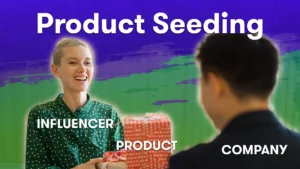Product Seeding: The Ultimate Influencer Marketing Hack?
After bouncing around tech start-ups and university literature programs, Joe has finally settled down as Billo’s Head of Content. Joe now spends his days writing ads about ads, teaching clients how to craft killer content, and combing through our web copy with a bold red Sharpie.

Convincing consumers to lap up your products takes hard work and patience. It requires building a brand, listening to feedback, and reaching out via assorted digital channels.
But what if there was a shortcut to success – a hack of some description?
Well, there might be. It’s called “product seeding” and describes a guerilla-style marketing technique to get ahead of rivals.
Read on to learn what it is, its benefits, and the companies already using it successfully.
What Is Product Seeding?
So, what is seeding in marketing?
Product seeding is where you send free product samples to influencers. The aim is to get them to share their love of your products with their audience voluntarily (instead of entering into an expensive agreement with them).
Most brands carefully curate the products they send to influencers and creators. This approach ensures items are relevant to their audiences (and therefore, more likely to be shared).
Brands start by identifying influencers that align with their values and mission. Targets should be in their niche and the right size.
Then, they send them products they think influencers will appreciate and use.
Critically, there’s no obligation for the influencer to post a review or any product-related content. Instead, brands hope influencers will enjoy their experience so much that they can’t help but create content around their experiences.
Part of this effect comes down to the principle of reciprocity. If you send something to someone for free, they naturally want to pay you back. That’s why product seeding is so masterful. It’s much more subtle than most marketing arrangements.
As we detail later, it is a strategy that’s worked for numerous brands in recent years. As such, there’s no reason it can’t work for you, too.
What Are The Benefits Of Product Seeding?
The benefits of product seeding marketing are vast. This section explains how powerful the technique can be.
Influencers Love It
First, it is worth mentioning that influencers love this strategy because it doesn’t involve pesky contracts or agreements. You simply send them something nice in the mail and they decide if they want to review it.
As such, the strategy is low-pressure and hands-off. Once influencers have products, nobody forces them to do anything, making anything they do look and feel more authentic.
Furthermore, influencers can also benefit from access to your newest products. Unlike the general public, they don’t have to wait to get their hands on the most recent samples.
This exclusivity excites content creators and their social media audiences because it adds value to their channels and facilitates audience growth. Influencers can expand their reach with new and interesting titles that draw in crowds.
Greater Brand Awareness
Greater brand awareness is another natural upshot. Brand seeding makes people more likely to view your products because influencers can reach audiences you can’t. You could leverage them to entice new markets you didn’t know you had.
Moreover, influencers often have more sway over their followers than brands. Audiences regularly hang on every word they say. For example, data from LinkedIn suggests that 75% of people use social media for purchasing advice and 69% trust influencer recommendations compared to 49% for brands.
More Personable Advertising
Another benefit of product seeding is the enhanced credibility it presents. It feels more real when an influencer recommends consumers buy something.
Traditional ads have a certain vibe about them. Companies will often polish them until there’s nothing genuine or authentic left. Many feel wooden and impersonal – just something users need to get through to access the next piece of content.
But influencer seeding is gritty and true to life. Many influencers tell it how it is, without putting any spin on it. What audiences see is what they get.
More User-Generated Content (UGC)
There’s also the benefit of more UGC. Brands can use their posts to show real people (not paid actors) using and reviewing their products. As such, 53% of shoppers say UGC makes them feel more confident when buying. It builds trust and brand loyalty that often lasts for years.
Because of this, 86% of retailers believe more authentic UGC in their paid and owned media would improve the performance of their ads and content. It could help you get more insights into customer experiences, how they use your products, and what to work on next.
Cheaper Marketing
Cheaper marketing is another benefit of product seeding. Adopting the right strategy can boost your return on investment (ROI) relative to other outreach methods.
For example, a Tomoson study found that companies made $6.50 for every $1 spent on influencer marketing, translating to an ROI of 550%. That compares to a standard pay-per-click (PPC) ROI of only 200% – less than half as much.
Furthermore, product seeding helps you reach new target Gen Z audiences inexpensively. The technique can get to hard-to-reach prospects using ad blockers or spam filters on their email accounts.
Ultimately with product seeding, you only pay for the product samples you send. You don’t need to hand over $10,000 monthly to Google AdWords or an expensive SEO agency just to keep treading water. Influencer payments can be high if you want a formal relationship with them. But you can avoid these with product seeding.
More Data
Finally, product seeding provides you with more data and insights you can use to learn more about your target audience and their preferences. Influencers can pass on sales information to you, helping you learn more about your ideal customers and what they want.
Don’t underestimate the power of this information. With this data, you can develop new marketing strategies and improve product development, creating something closer to what consumers want. Using the best product management tools can help organize and apply these insights more effectively throughout the development process.
Effective Product Seeding Strategies
So how does product seeding work? What do you need to do to be successful with it?
Think About What You Want To Achieve
Creating a world-beating campaign begins with planning. Mapping out the steps will help you generate better results for your firm.
Start by considering what you want your product seeding campaign to achieve. What do you want it to do?
Goals include:
- Raising awareness about a new product
- Driving sales of an existing line
- Reaching out to an audience you can’t access normally
- Learning more about who buys from you
Select Influencers That Match Your Objectives
Once that’s done, look for the right influencers in your niche. Find individuals with authentic audiences who will love your products.
Don’t reach out to influencers solely because they are successful. Broader follower bases aren’t necessarily better.
Instead, try to profile their audiences to see who follows them. Look for influencer followers who match your own across various metrics.
Also, probe the engagement rate of the influencers’ content. See how many people truly watch their videos.
You want influencers with reasonable content engagement statistics. The more compelling their content, the more likely their audience is to see your products.
Usually, it’s better to target a handful of so-called “micro-influencers” – people with 1,000 to 100,000 followers – and work up from there. Sometimes, bigger names will run with your product, but it is rare. Most already have deals and a packaged schedule.
If you pitch to a big name, offer exclusivity. Tell them they’re the only influencers to whom you are sending samples. That way, they can monopolize the online traffic wanting to learn more about what you sell.
Create Your Product Seeding Package
Next, think about how you will create a compelling product seeding package. Ask yourself what you would want to receive from a brand if you were an influencer.
Effective product seeding packages usually come with handy information the influencer needs to streamline content production. Creators shouldn’t have to go through hours of research before publishing.
Furthermore, pack your product in a nice box. Giving the influencer something visual to work with makes producing compelling content more straightforward.
Tell them they should be transparent about being sent the products for free. Don’t ask them to conceal anything – if word gets out, it won’t go down well with their audience.
Don’t Attach Any Strings
When sending information to the influencer, avoid the temptation to tell them what to do. Give them free rein and see what happens. Trust that they will respond.
People are so used to give-and-take that it’s nice when something non-transactional happens. In today’s economy, it is valuable leverage to get the influencer to produce high-quality content of their own volition. It frees them up to be more inventive and creative when you remove all strings (including sending the sample back if they don’t use it). They don’t have to follow the corporate line and can improvise (which is ultimately what you want).
See How It Performs
Finally, wait and see how product seeding performs. Sometimes, you will be lucky and influencers will publish content about your products immediately. Other times, you may need to wait.
If you aren’t getting any traction, check that you’re doing the following:
- Sending products to the right influencers
- Building a compelling product sample package
- Removing any obligations (such as demanding a product showcase or favorable review)
If you can stick to these rules, something will eventually happen. When it does, test the effectiveness of the campaign. Measure the revenue it generates with affiliate link tracking and calculate the ROI.
Real-World Examples Of Companies Using Product Seeding Successfully
So, which brands have used product seeding successfully?
GoPro
GoPro took the portable adventure camera industry by storm several years ago. But it didn’t do it by cramming conventional ad channels with its content. Rather, it reached out to adventurous influencers and got them to sell its product on its behalf. Targets included:
- Travel bloggers
- Extreme athletes
- Adventure-lovers and explorers
SuperGoop
SuperGoop is another example of a company that got influencer gifting right. The group – which makes beauty products – sent samples to health and wellness influencers to try out. Social media personalities then tried the product on their faces to see if it generated results. And – no surprise to SuperGoop – it did. Many reported brighter, glowy complexions in as little as seven hours – social proof in action.
Levi’s
Lastly, iconic brand Levi’s has been trying to get the attention of influencers with its product seeding strategy. The company sends its products to diverse people to make the point that its clothes look great on anyone, regardless of size, gender, or color.
However, Levi’s approach is even cleverer than that. It also targets influencers with a carefree vibe that chimes with its brand. It wants to show its clothes in their element: on hot sunny days, beside the beach, or on lazy walks through the park.
The Challenges Of Product Seeding
By now, you should see how product seeding could help you drum up online attention. Getting influencers to talk about (or use) your products is a form of persuasive social proof.
But, as with any marketing strategy, you will face challenges. These include:
- ROI measurement. Calculating return on investment from an influencer campaign isn’t straightforward. You can use proxy metrics, like likes and comments, but these only provide limited information. Knowing the number of sales and where traffic is coming from is what you really want to know. You can do this with affiliate links, but this makes your commercial arrangement with the influencer more conspicuous.
- Product waste. Sometimes, you will send products to influencers and they will never use them. Unfortunately, this risk comes with the territory. That’s why it is so critical to choose influencers aligning with your requirements and audience.
- Influencer outreach. Even talking to influencers and saying something that grabs their attention is also challenging. You might not have the right script, or they may just ignore you.
If you do reach out to influencers, tell them about the campaign you are running. This background information helps them develop a plan for placing your products.
Continue learning:
Head of Content
After bouncing around tech start-ups and university literature programs, Joe has finally settled down as Billo’s Head of Content. Joe now spends his days writing ads about ads, teaching clients how to craft killer content, and combing through our web copy with a bold red Sharpie.

Authentic creator videos, powered by real performance data
22,000+ brands use Billo to turn UGC into high-ROAS video ads.
How to Find Micro Influencers for Your Brand’s...
Looking for micro influencers for your brand’s next campaign? You’re [...]...
Read full articleBeyond the Ad: Influencer Marketing Services for...
Sponsored posts alone won’t cut it in 2025. Global influencer-marketing [...]...
Read full articleTop 20 TikTok Influencers for 2025
Having rapidly evolved from a short-form video app predominantly used [...]...
Read full article



